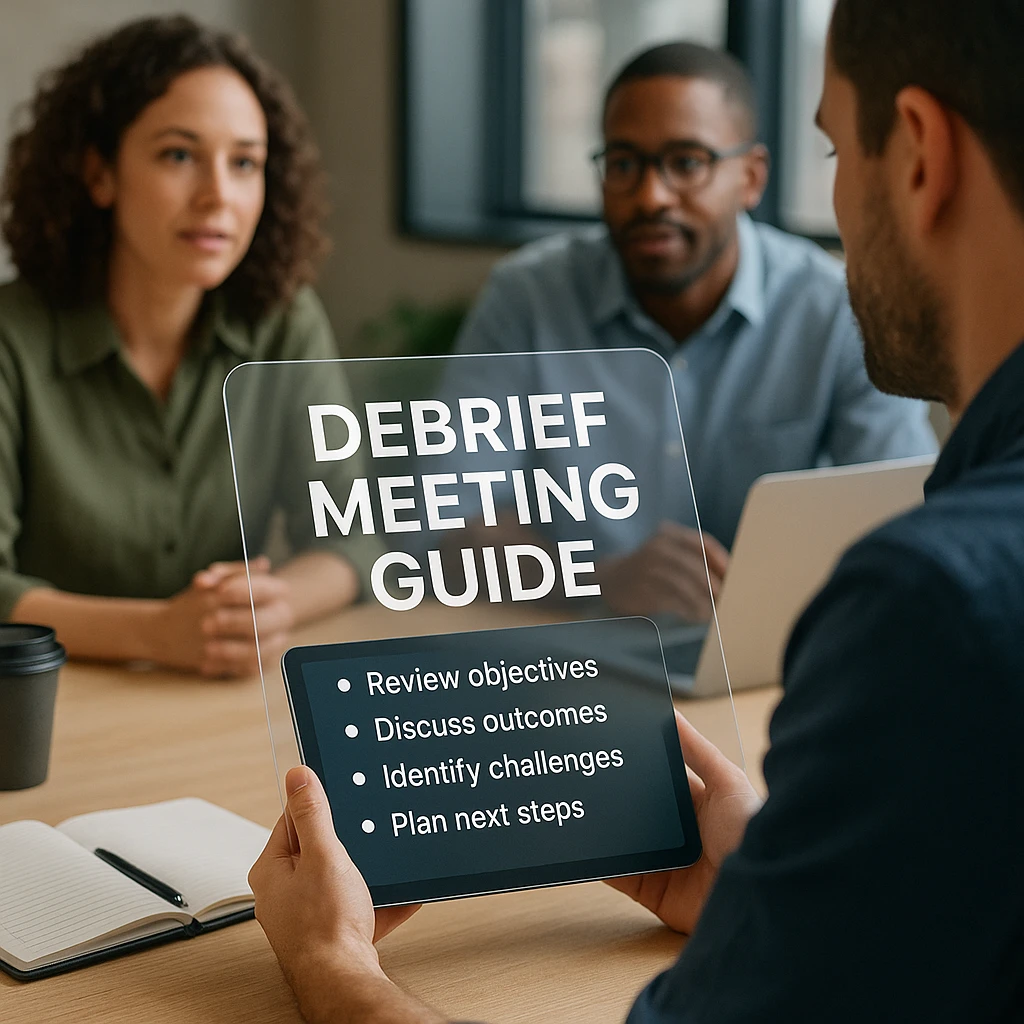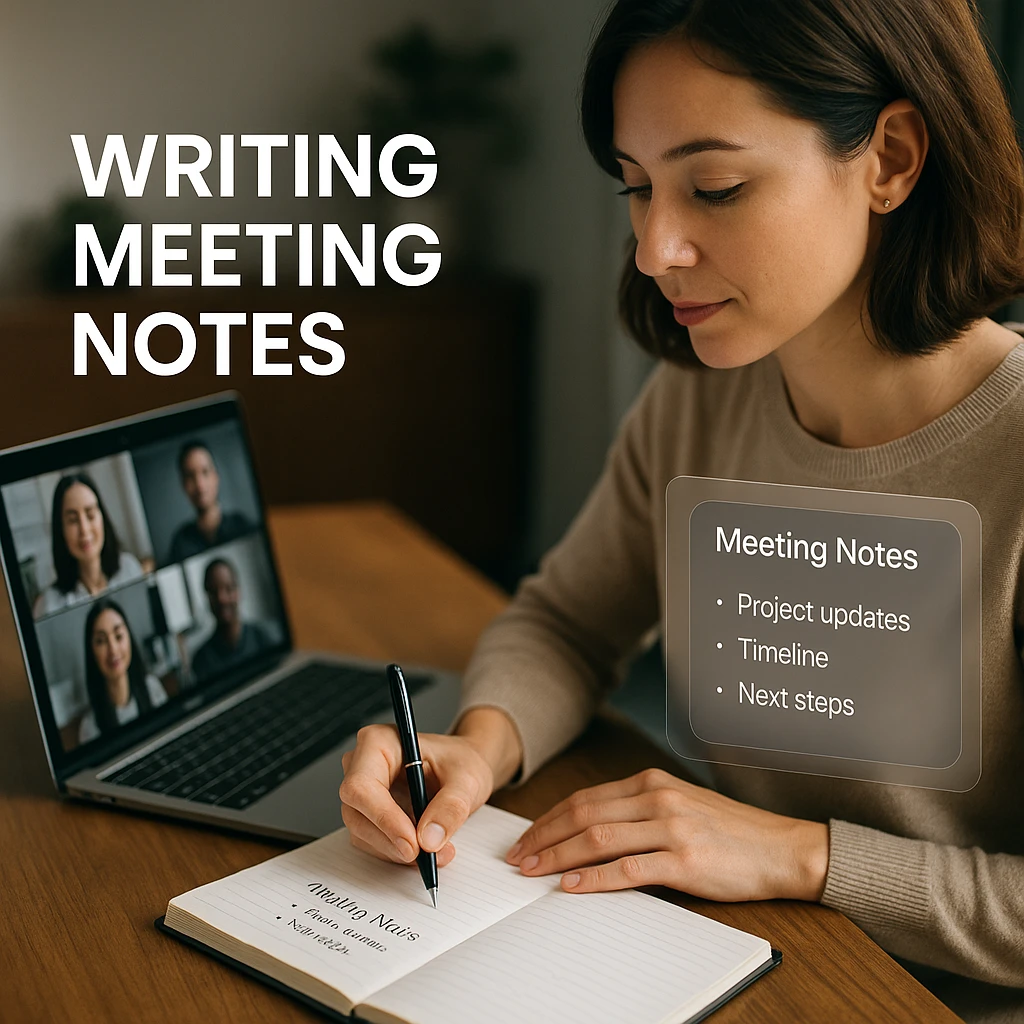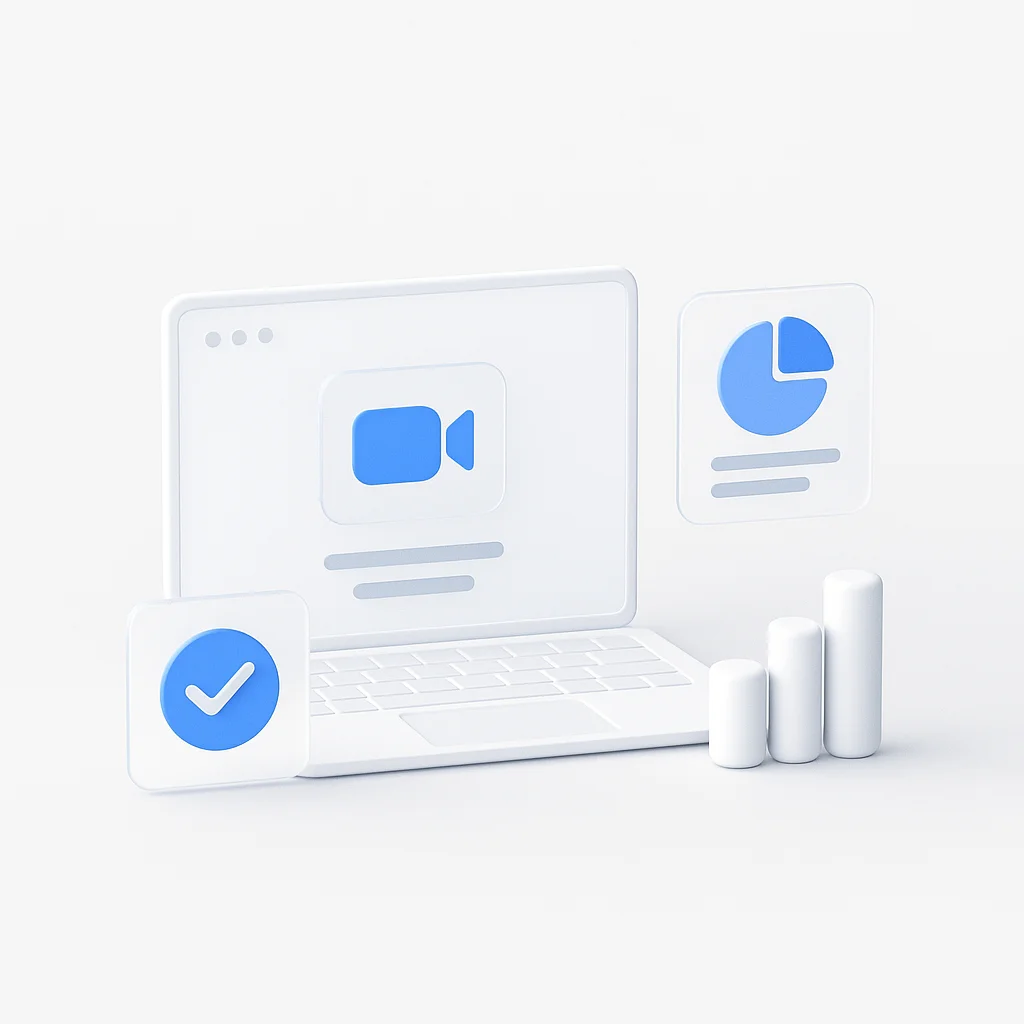The project is over. The event is done. But the most valuable part is just beginning. A well-run debrief meeting is the difference between repeating the same mistakes and achieving breakthrough performance on your next initiative.
Many teams either skip debriefs entirely or hold “blame-game” sessions that are unproductive and demoralizing. This leads to lost lessons and unresolved issues festering within the team. This guide will teach you how to conduct a successful debrief, provide powerful question lists, and share proven debrief meeting agenda templates and frameworks that turn reflection into actionable improvement.
What is a Debrief Meeting? (And What It Is Not)
The Core Purpose: A Structured Reflection for Improvement
A debrief meeting is a collaborative session to analyze a completed project or event to understand successes, failures, and key learnings. Unlike casual post-project discussions, debriefs follow a structured approach designed to extract maximum value from the experience.
The primary goal isn’t to assign blame or celebrate victories—it’s to create a clear roadmap for doing better next time. This systematic reflection process helps teams identify patterns, understand root causes, and develop concrete action plans for future improvements.
Debrief vs. Post-Mortem vs. Retrospective
Understanding the distinctions between these similar-sounding meetings is crucial for choosing the right approach:
Debrief: Focuses on the performance and execution of a specific event or mission. Used across industries from military operations to marketing campaigns. The emphasis is on “what happened” and “what we learned.”
Post-Mortem: Typically used for projects that failed or encountered significant problems, focusing heavily on what went wrong. The tone is more investigative, aimed at preventing future failures.
Retrospective: An Agile/Scrum term for reviewing a work sprint, focusing on the team’s process and working relationships. These are usually shorter, more frequent meetings with a continuous improvement mindset.
The Foundation of a Great Debrief: Psychological Safety
Why You Can’t Get Honest Feedback Without It
Psychological safety is the shared belief that team members can speak up with ideas, questions, concerns, and mistakes without fear of punishment or humiliation. Without this foundation, debrief meetings become exercises in blame avoidance rather than genuine learning.
When team members feel safe, they share honest perspectives about what really happened, including their own mistakes and the challenges they observed. This honesty is essential for identifying the real root causes of problems and understanding the true factors behind successes.
How to Create a “Safe Space” for Your Debrief
Set the Tone: As the leader, start by sharing a mistake you made during the project. This vulnerability signals that the meeting is about learning, not judgment.
Establish Ground Rules: Make explicit statements like “We critique the process, not the people” and “Assume positive intent.” Post these visibly during the meeting.
Encourage Active Listening: Ask participants to listen to understand, not just to respond. Model this behavior by asking clarifying questions rather than defensive statements.
Focus on Systems, Not Individuals: When problems arise, guide discussion toward systemic issues, missing processes, or unclear expectations rather than individual performance.

How to Conduct a Successful Debrief Meeting: A 7-Step Guide
1. Set the Agenda & Share Data Early
Send out the agenda and any relevant metrics 24-48 hours in advance. Include quantitative data like budget vs. actuals, timeline performance, quality metrics, or customer satisfaction scores. This preparation time allows participants to reflect before the meeting and come prepared with thoughtful insights.
2. Determine the Right Attendees
Include representatives from all key functions without overcrowding the meeting. The ideal size is 6-8 people maximum. Consider these roles:
- Project/event leadership
- Key team members from different disciplines
- Customer-facing representatives
- Technical specialists (if relevant)
- Stakeholders who can implement changes
3. Start with the Goals
Begin by restating the original goals of the project or event. This common reference point helps frame the entire discussion and provides objective criteria for evaluating success and failure.
4. Facilitate the Discussion Using a Framework
Guide the conversation using one of the structured frameworks outlined in the next section. This prevents the meeting from becoming a random complaint session and ensures comprehensive coverage of important topics.
5. Focus on “What” and “Why,” Not “Who”
Steer the conversation away from blame and towards understanding root causes. When someone mentions a problem, ask “What led to that situation?” rather than “Who was responsible for that?“
6. Capture Everything Visually
Use a whiteboard, digital collaboration tool, or meeting recorder to capture all key points visually. Visual documentation helps participants see connections between issues and ensures nothing gets lost.
7. Define Clear Action Items
The meeting is only successful if it results in concrete plans for improvement. End with specific action items that include who, what, and when for each commitment.
Debrief Meeting Frameworks & Agenda Templates
Framework 1: The “What? So What? Now What?” Model
This three-part structure provides comprehensive coverage while maintaining focus:
What? (What happened? State the objective facts)
- Review timeline of events
- Present quantitative data
- Share qualitative observations
- Document decisions made
So What? (Why is this important? What is the impact?)
- Analyze the implications of what happened
- Identify patterns and root causes
- Assess impact on stakeholders
- Evaluate against original objectives
Now What? (What do we do differently next time?)
- Develop specific improvement actions
- Assign ownership and timelines
- Create accountability measures
- Plan follow-up and review processes
Framework 2: The “Start, Stop, Continue” Model
This framework is particularly effective for teams looking to make incremental improvements:
Start: What should we start doing that we aren’t currently doing? Focus on new processes, tools, or behaviors that could improve future performance.
Stop: What should we stop doing because it’s ineffective or inefficient? Identify activities that waste time, create confusion, or don’t add value.
Continue: What is working well that we should continue doing? Recognize and systematize the practices that contributed to success.
Framework 3: The “4Ls” Agile Retrospective
This framework encourages both emotional and practical reflection:
Liked: What did you really like about the project? This focuses on positive experiences and successful practices worth repeating.
Learned: What new things did you learn? Capture both technical skills and process insights gained during the project.
Lacked: What was missing that could have helped? Identify gaps in resources, information, or support that hindered performance.
Longed For: What do you wish we had? This future-focused question helps identify aspirational goals and needed improvements.
30+ Powerful Debrief Questions to Ask

Questions About Performance & Goals
- Did we achieve our original goals? If not, what prevented us?
- What was the single biggest success of this project?
- What was our biggest unforeseen challenge?
- Which metrics exceeded expectations? Which fell short?
- What would success have looked like if we had unlimited resources?
- How did our actual timeline compare to our planned timeline?
- What assumptions proved incorrect?
- Where did we over-engineer or under-prepare?
Questions About Process & Teamwork
- Did our team work well together? Where were the communication breakdowns?
- Did we have the right tools and resources to succeed?
- Was there anything that slowed us down unnecessarily?
- How effective were our decision-making processes?
- What information did we need that we didn’t have?
- Where did handoffs between team members work well or poorly?
- How could we have better supported team members who struggled?
- What would we do differently with the same team and resources?
Questions About External Stakeholders
- Did the event/project fulfill stakeholder expectations?
- What feedback did we receive from customers or end users?
- How could we have better managed stakeholder communications?
- What surprised our stakeholders (positively or negatively)?
- Where did we excel in stakeholder management?
- What relationships were strengthened or damaged during this project?

Using AI to Run Better Debrief Meetings
The Challenge of Facilitation vs. Documentation
One of the biggest challenges in running effective debrief meetings is the dual demand of facilitating meaningful discussion while capturing every insight accurately. When leaders try to do both simultaneously, they often miss important nuances or fail to ask the right follow-up questions.
How ScreenApp Can Help
ScreenApp’s meeting summarizer provides an ideal solution for debrief sessions:
Full, Unbiased Transcript: Creates a perfect record of the conversation to refer back to, ensuring no insights are lost or misremembered.
AI-Powered Summary: Automatically extracts key themes, successes, challenges, and action items from the discussion, saving hours of manual note compilation.
Focus on Facilitation: Frees up the meeting leader to focus on guiding the conversation, ensuring psychological safety, and asking the right questions rather than frantically taking notes.
Searchable Archive: Past debrief sessions become a searchable knowledge base for identifying recurring patterns across multiple projects.
The combination of human facilitation and AI documentation creates the optimal environment for honest reflection and actionable insights.
Best Practices for Different Types of Debriefs
Project Debrief Meeting
Focus on deliverables, timelines, and process effectiveness. Include detailed analysis of scope changes, resource allocation, and stakeholder management. These debriefs often benefit from quantitative data analysis.
Event Debrief
Emphasize attendee experience, logistical execution, and stakeholder feedback. Include vendors, volunteers, and attendees in the feedback process. Consider both immediate reactions and longer-term impact assessment.
Campaign Debrief
Analyze performance metrics, audience response, and ROI. Include creative effectiveness, channel performance, and competitive analysis. Focus heavily on data-driven insights and market response.
Post-Mortem Meeting
When things go significantly wrong, maintain a blame-free environment while conducting thorough root cause analysis. Focus on systemic failures rather than individual mistakes, and prioritize preventing similar issues in the future.
Common Debrief Meeting Mistakes to Avoid
The Blame Game
When discussions focus on who made mistakes rather than what systemic issues led to problems, teams learn less and become defensive. Redirect blame-focused comments toward process improvement opportunities.
Surface-Level Analysis
Stopping at the first explanation for problems prevents teams from identifying deeper root causes. Use techniques like “Five Whys” to dig deeper into underlying issues.
Lack of Action Items
Debriefs that end with great insights but no concrete next steps waste the investment in reflection time. Always conclude with specific, assigned action items.
One-Sided Perspective
Including only leadership or only team members provides an incomplete picture. Ensure multiple perspectives are represented in the discussion.
Rushing the Process
Effective reflection takes time. Don’t cut debriefs short due to schedule pressure—the insights gained are often worth more than the time invested.
Frequently Asked Questions
When is the best time to hold a debriefing meeting?
Schedule debriefs within 1-2 weeks of project completion while details are fresh but emotions have cooled. For long projects, consider interim debriefs at major milestones to capture learnings before they’re forgotten.
Who should be invited to a project debrief?
Include key team members from all functions, project leadership, and representatives from affected stakeholder groups. Keep the group size manageable (6-8 people) to encourage participation.
How do you handle disagreements or negative feedback in a debrief?
Acknowledge different perspectives as valuable and focus on understanding the root causes behind disagreements. Use phrases like “Help me understand your perspective” to explore differing viewpoints constructively.
What’s the ideal length for a debrief meeting?
Most effective debriefs last 90-120 minutes. This provides enough time for thorough discussion without causing fatigue. For smaller projects, 60 minutes may suffice.
How is a debrief different from a regular team meeting?
Debriefs are specifically structured for reflection and learning, with a clear focus on past performance and future improvement. Regular team meetings typically focus on current status and upcoming tasks.
Should debriefs be mandatory or voluntary?
While participation should feel voluntary to maintain psychological safety, debriefs should be a standard part of your project lifecycle. Frame them as learning opportunities rather than evaluations.
Conclusion: Turning Lessons Learned into Lessons Applied
The goal of a great debrief isn’t just to talk about what happened—it’s to create a clear, committed plan to ensure that successes are repeated and mistakes are not. That’s how great teams grow.
Effective debrief meetings require preparation, structure, and skilled facilitation, but the investment pays dividends in improved team performance and reduced repeat mistakes. By following the frameworks and best practices outlined in this guide, you can transform your post-project discussions from blame sessions into powerful learning experiences.
Remember that the true measure of a successful debrief isn’t the quality of the discussion—it’s the positive changes implemented in subsequent projects. Use tools like meeting note taker to ensure your valuable insights are captured and can be referenced when planning future initiatives.
Start implementing these debrief practices with your next completed project. Your team’s future performance depends on the lessons you learn today.



